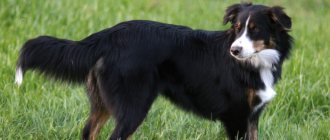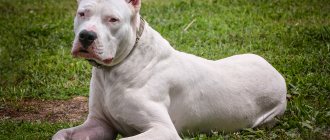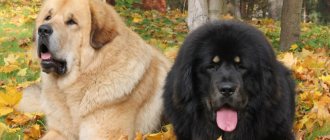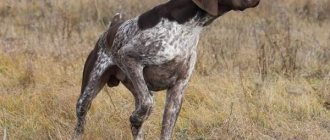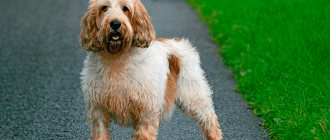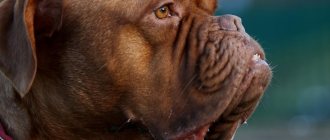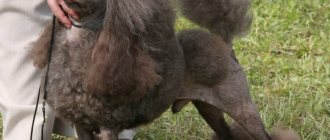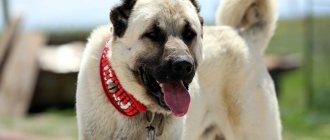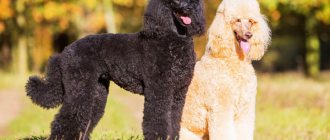“Svet Posada” is a private kennel of Maremmo-Abruzzese Shepherd Dogs in the RKF/FCI system (certificate No. 17777). All litters of puppies are born from purebred dogs in compliance with the rules of the RKF Breeding Regulations.
We strive to produce healthy dogs that meet the standard of the Maremmo-Abruzzese Sheepdog (Maremma) breed. When selecting a pair, we study the pedigree, evaluate the health, appearance, temperament and character of the partner. Our dogs have RKF/FCI documents. There are no Maremmo-Abruzzese Shepherd puppies without a pedigree or unplanned puppies in our kennel. Litters of puppies are born in compliance with all the rules of the RKF Breeding Regulations.
We are ready to discuss all your questions at any time.
Description and features
The first standard accurately describing the breed's condition was drawn up in 1924. In 1958, a standard was agreed upon and printed, combining two versions of the dog: the Maremese and the Abruzzese. The latest edition of the standard was released by the FCI association in 2015. It describes in detail what an Italian Shepherd should ideally be like.
- General description. Cattle, herding and guard dogs are quite large in size. The animal is hardy. It tolerates work well in mountainous areas and on the plain.
- Basic dimensions. The body is elongated. The length of the body is 20% greater than the height at the withers. The head is 2.5 times shorter than the height at the withers. The transverse size of the body is half the height at the withers.
- Head. Large, flattened, resembles a bear's head.
- Scull. Wide with an inconspicuous sagittal ridge on the back of the head.
- Stop. Smooth, low forehead, the forehead meets the muzzle at an obtuse angle.
- Nose. Noticeable, black, large, but does not violate the general features. Constantly wet. The nostrils are fully open.
- Muzzle. Wide at the base and narrowed towards the tip of the nose. Occupies approximately 1/2 the length of the entire head. The transverse size of the muzzle, measured at the level of the corners of the lips, is equal to half the length of the muzzle.
- Lips. Dry, small, covering the upper and lower teeth and gums. Lip color is black.
- Eyes. Chestnut or brown.
- Teeth. The set is complete. The bite is correct, scissor-shaped.
- Neck. Muscular. 20% shorter than the length of the head. Dense fur growing on the neck forms a collar.
- Torso. The Maremma is a dog with a somewhat elongated body. The linear size of the body refers to the height from the floor to the withers, as 5 to 4.
- Limbs. Straight, set vertically when viewed from the side and front.
- The paws are supported by 4 toes, which are pressed against each other. The finger pads are distinct. The entire surface of the paws, except for the pads, is covered with short, thick fur. The color of the claws is black, dark brown is possible.
- Tail. Well pubescent. In a calm dog it is lowered to the hock joint and below. An excited dog raises its tail to the dorsal line of the back.
- Movement. The dog moves in two ways: at a walk or at a vigorous gallop.
- Wool cover. The guard hair is mostly straight, the undercoat is thick, especially in winter. Wavy strands are possible. The fur on the head, ears, and ventral part is shorter than on the rest of the body. The molt is not extended and occurs once a year.
- Color. Plain white. There may be slight hints of yellow, cream and ivory.
- Dimensions. The height of males is from 65 to 76 cm, females are more compact: from 60 to 67 cm (at the withers). The weight of males is from 36 to 45 kg, females are 5 kg lighter.
The professional specialization of Italian Shepherds has made their muscles strong and strengthened their bones. This is confirmed by photos of the Abruzzese maremma . Obviously, these shepherds are not very fast - they will not be able to catch up with a deer or a hare. But they can easily force an attacker, be it a wolf or a man, to abandon his intentions.
Cynologists explain the white color of dog fur by shepherding work. The shepherd sees white dogs from afar, in the fog and twilight. Can distinguish them from attacking gray predators. In addition, white wool reduces exposure to bright high-altitude sun.
Dogs most often work in a group. Their task does not include direct combat with wolves. By barking and collective action they must drive away attackers, be they wolves, feral dogs or bears. In the old days, the equipment of dogs included a collar with spikes - a roccalo. Animal ears have been and are still cropped in countries where this operation is permitted.
Caring for the Maremmo-Abruzzese Shepherd Dog
The Maremma does not require special care, but there are some rules that should be followed to ensure that the dog is always in good shape.
What to feed your pet
The Abruzzese Shepherd is a working breed, so they need to choose the right diet. You can give your animals good premium food. If desired, you can feed the dog natural food. The diet includes lean meat, vegetables, cereals, dairy products
It is important to ensure that your pet has enough of all nutrients, so it is recommended to give additional vitamin complexes
Important! During the puppy's growth period, it is worth paying attention to chondroprotectors to avoid problems with joints and cartilage in the future.
Features of hair care
The Maremma has a thick coat, so you should brush the dog at least once every 4-5 days. During molting, the procedure should be repeated every day. The dog is rarely bathed; once every six months is enough.
Ears and eyes should be checked and cleaned regularly, and nails trimmed if necessary. To keep their teeth clean, shepherd dogs are given brain bones and special treats. It is imperative to vaccinate and treat against parasites.
Walking and physical activity
If a shepherd is kept in an apartment, it will need at least three hours of walking. If your pet lives on the street, then it is best to play different games with him more often, develop his intelligence and physical abilities. At the age of up to 4 months, the dog should walk approximately 2 km, at six months – approximately 6 km.
Kinds
Until the middle of the 20th century, the breed was divided into 2 types. was considered a separate breed . An independent breed was the herding dog from Abruzzo. Once upon a time this was justified. Maremmo dogs herded sheep on the plains and swamps. Another variety (from Abruzzo) spent all its time in the mountains. Plain animals were somewhat different from mountain animals.
In 1860, Italy was unified. Borders have disappeared. The differences between the dogs began to level out. In 1958, the unity of the breed was formally consolidated, and shepherd dogs began to be described by a single standard. In our time, past differences were suddenly remembered in Abruzzo. Dog breeders from this region want to distinguish their dogs into a separate breed - the Mastiff from Abruzzo.
Dog handlers from other provinces do not lag behind the residents of Abruzzo. There are proposals to divide the breed into subtypes, based on small differences and their places of origin. After the implementation of such ideas, shepherd dogs may appear from Apullio, Pescocostanzo, Maiello and so on.
How to choose a puppy
- If you do not plan to raise a working shepherd dog from a Maremma to guard livestock and property, look for breeders who breed show and domestic lines of the breed. Their charges are more focused on human contact and less suspicious of others.
- A good Maremma puppy is a brave puppy! If at the entrance to the nursery you are barked by a four-legged shaggy ball, you can rest assured that in the future he will grow into a brutal and stern watchman.
- It is not advisable to take a pair of same-sex puppies: both in work and in everyday life, Maremma males and females get along better with representatives of the opposite sex.
- Assess the living conditions of the puppies in the kennel: dogs should not be locked up and afraid of people. An unpleasant smell in the room where animals live is also not the best characterization of the breeder.
- It will be a great advantage if sires have their litter tested for genetic joint dysplasia.
- Always check the age of the manufacturers. Keep in mind that Maremma Abruzzese Shepherd bitches are allowed for breeding from the age of 18 months and finish their breeding “career” by the age of 8 years.
- Find out from the seller what the litter of puppies is for the year. Ideally, a maremma breeds once every 12 months. In some cases, two litters per year are allowed - FCI no longer registers more than that.
History of the breed
In fragments of the treatise De Agri Cultura, dating back to the 2nd century BC, the Roman official Marcus Porcius Cato describes three types of dogs:
- herding dogs (canis pastoralis) - white, shaggy, large animals;
- Molossians (canis epiroticus) are smooth-haired, dark, massive dogs;
- Spartan dogs (canis laconicus) are fast-footed, brown, smooth-haired hunting dogs.
Probably the description of canis pastoralis by Marcus Cato is the first mention of the ancestors of modern Italian cattle dogs. The antiquity of the origin of the breed is confirmed by the work of the Roman historian Junius Moderatus Columella “De Re Rustica”, dating back to the 1st century BC.
In his opus, he dwells on the importance of white coat color for herding dogs. It is this color that makes it possible for a shepherd in the dark to distinguish a dog from a wolf and direct his weapon against the beast without injuring the dog.
Italian Maremma Shepherds are constantly described, painted, immortalized in frescoes, and laid out with colored glass in mosaic paintings. In works of art, the slowness, tranquility and piety of rural life were symbolized by humble sheep. They were guarded by strong maremmas. To be convincing, the dogs wore collars with spikes.
In 1731, a detailed description of the Maremma appeared. The work “Pastoral Law” was published, in which lawyer Stefano Di Stefano provided data on herding dogs. In addition to describing the physical parameters, it talked about the nature of the maremma . His independence, combined with devotion, was emphasized.
The author assured that the dog is not bloodthirsty, but is capable of tearing anyone apart at the command of the owner. The Maremma performs its difficult and dangerous work as a shepherd on a modest diet. It consisted of bread or barley flour mixed with whey obtained during the cheese making process.
The method of grazing sheep played an important role in the formation of the breed. In summer, flocks of sheep fed on the mountain pastures of Abruzzo. By autumn it was getting colder, the herds were driven to the flat marshy area of the Maremma. Dogs walked along with the herds. They mixed with local animals. The differences between lowland and mountain dogs disappeared.
In Genoa, in 1922, the first club of Italian herding dogs was created. It took two years to compile and edit the breed standard, which calls it the Maremma Sheepdog and mentions that it can also be called the Abruzzi. For a long time after this, dog handlers could not decide on the name of the breed.
Dear future dog owners!
If you decide to buy a maremma, then before purchasing a puppy, ask yourself the question: are you ready to spend a large amount of your time on training and socializing the dog until it reaches the age of one year, and then regularly maintain the acquired skills?
Remember, for a dog to behave adequately, its head should ALWAYS be occupied with daily activities, of course, without “overload”, in a playful way.
It is important for every owner to know that Maremmas are dogs that are very different from other dog breeds. Many people are mistaken in believing that if the name of the breed contains the word “shepherd”, then the Maremma should be raised in the same way as other shepherds. Alas, today many trainers who have no experience working with Maremma and do not know the characteristics of this breed begin to train the dog incorrectly, and as a result, they get a completely different result than they expected.
One of the instructors said about the Maremma that their problem is that they are thinking dogs. I wonder whose problem it is, the dog’s or the instructor’s?)))
Unfortunately, today many trainers who have no experience working with Maremma and do not know the characteristics of this breed begin to train the dog incorrectly, and as a result, they get a completely different result than they expected. One of the instructors said about the Maremma that their problem is that they are thinking dogs. I wonder whose problem it is, the dog’s or the instructor’s?)))
The ancestors of the Maremma were wolfhounds, so the most ancient purpose of this dog was to protect flocks of sheep in pastures, acting as the main assistant to the shepherd. Often the white dog had to be left alone with the flock and make any decisions on its own, this influenced the formation of the freedom-loving and independent character of the Maremma.
Remember that love and understanding are important in raising a Maremma. The dog should not be physically punished. This will lead to a loss of your authority in the eyes of your pet, which will then be extremely difficult to restore. If your friend has done something wrong, punish him with your voice, but do not use physical violence. You can reason with a teenager or an adult shepherd by pressing him to the ground by the withers and growling menacingly in his ear, showing that you are in charge. From the very first minutes of communication with a puppy, he must understand that you are the leader of the pack, and it will always be so. You make absolutely all decisions, not the dog. The dog follows your commands: when to start eating, when to jump out of the trunk of a car, to leave the enclosure with the door already open, etc. You should be the first to enter somewhere, not the dog. The dog should not come closer than two meters to the dinner table (if you let the dog into the house or at a picnic), because the leader is at the table! Everything is like in a pack of animals. And remember, the dog perceives your pity as your weakness, and your authority as a leader in its eyes decreases, as a result, the pet’s obedience becomes worse.
Don't pay attention to people who claim that a maremma should only know two basic commands - “sit” and “come”. This is wrong! A dog can quite easily and quickly master the entire course of general training. If you start training your pet from an early age, then already at four to five months your puppy will be able to understand and carry out all the basic commands (“come to me”, “lie down”, “sit”, “place”, etc.). In training, the main thing is to be able to interest the dog, which is much easier to do with a puppy, then every dog walk and training will bring you both a lot of positive emotions.
Despite all this, 8-9 month old puppies can also quickly achieve good training results
It is important for a breeder to choose the right approach to training their pet. Before purchasing a grown-up puppy, ask its owner whether the dog has been socialized and whether it walks on a leash. If this is not the case, then it will be possible to achieve something from the maremma, but it will be much more difficult
If this is not the case, then it will be possible to achieve something from the maremma, but it will be much more difficult.
Treat your dog with respect! And always remember that all the gaps in your pet’s upbringing are your shortcomings!
The initial training of the Maremmo-Abruzzese Shepherd Dog is no different from the training of dogs of other breeds. Puppies remember everything very quickly and are easy to train. However, as your dog matures, he begins to question your commands. And here you should not show your weakness, otherwise the pet will simply “sit on your neck.”
To summarize all of the above, it is worth emphasizing that the process of training and raising a dog is continuous and lasts its entire life.
Character
The standard describes the character of the maremma something like this. The Maremma breed is created for herding work. She is involved in driving, herding and protecting the sheep flock. Treats animals and shepherds as his family. When working with animals, she makes decisions about further actions. He eagerly follows the orders of his masters.
When attacking sheep she controls, she does not seek to destroy the beast. It considers its task completed when the predator is driven away to a certain distance. This way of working increases the efficiency of the shepherd’s actions: the Maremma never leaves the herd for long.
The Maremma treats strangers without aggression, but is wary, and welcomes members of the owner’s family with joy. She takes care of the children and calmly accepts their liberties. The character of the dog allows, in addition to peasant work with animals, to be a companion, rescuer and even a guide.
Basic moments
- The breed is considered rare and is not common everywhere. Maremma is most valued by farmers in Italy, the USA, Australia and Canada.
- The independent nature of the animals is the result of many years of working breeding with minimal contact with humans.
- In Australia, since 2006, Maremma-Abruzzese Shepherd Dogs have been involved in protecting the populations of blue penguins and wombats.
- You should not have a maremma if your home is constantly open to large noisy companies and new acquaintances. Representatives of this family do not favor strangers, mistaking them for a potential threat.
- Shepherd dogs are not hyperactive and do not need intense sports activities, but it is difficult for them to adapt to life in an apartment.
- The breed is not created for service work and complete submission: Maremma-Abruzzese Shepherd Dogs perceive their owner as an equal companion, whose opinion is not always worth listening to.
- Maremmas have a very developed desire for “guardianship” activities, therefore, in the absence of sheep, the dog guards children, poultry and even small decorative pets.
- The snow-white coat of the Maremma-Abruzzese Shepherd almost does not smell like a dog, even if it is wet. The exception is unkempt, sickly individuals.
- Maremma litters range from 6 to 9 puppies.
Nutrition
For most of their history, dogs lived alongside shepherds and sheep. Their diet was peasant. That is, modest and not very diverse, but absolutely natural. Written sources confirm that the dogs were fed bread and flour mixed with whey. In addition, the diet included everything that the shepherds ate, or rather, what was left from the peasants’ meals.
In our time, food asceticism has faded into the background. Dogs receive food prepared especially for them. The exact determination of the amount of food and its composition depends on the animal’s age, activity, living conditions, and so on. The total volume of food lies within 2-7% of the animal’s weight.
The menu should contain animal proteins, plant and dairy components. Approximately 35% comes from meat products and offal. Another 25% are vegetables, stewed or raw. The remaining 40% is boiled cereals combined with dairy products.
Which owner is it suitable for?
This dog is perfect for an active person who monitors his physical fitness and likes to go for long walks or jogs in the mornings and evenings. She will happily accompany her owner, protecting him from various troubles and at the same time carefully studying the environment.
It is better not to get this breed of dog for people who have health problems, because in the event of any conflict situation on the street with another member of the canine family or a person, it will be quite difficult for a sick and weak person to contain the ardor of his dog and not allow him to enter into a fight.
The owner must have pronounced leadership qualities and be distinguished by perseverance and self-confidence, so that the dog recognizes him, if not as its leader, then at least as its equal. A loud, well-placed commanding voice will only help strengthen your authority with the dog.
Reproduction and lifespan
Maremma Sheepdogs nowadays are divided into two categories. The first, as befits a shepherd dog, spends its entire life among sheep. Leads a semi-free existence. Since the sheep are guarded not by one dog, but by a whole company, Maremma puppies are born with minimal human intervention.
When living under the constant care of a person, reproduction problems must be resolved by the owner. First of all, when a puppy appears in the house, you need to decide: to provide the animal and the owner with a quiet life or to preserve their reproductive function. Castration or sterilization is most often the right solution, relieving many problems.
A fully functioning dog becomes ready to reproduce at around 1 year of age. But it’s worth waiting a while: breeding bitches starting from the second heat. That is, when she is at least 1.5 years old. For male dogs, 1.5 years of age is also a good time for paternal debut.
Breeders are well acquainted with organizing and conducting meetings for dogs to solve reproductive problems. Matings of purebred animals are planned for a long time in advance. Inexperienced dog owners should seek comprehensive advice from the club. Properly resolved breeding issues will keep the dog healthy for the entire 11 years that a Maremma lives on average.
Where to buy a Maremmo-Abruzzese Shepherd puppy
Not so long ago, it was almost impossible to find a Maremmo-Abruzzese Shepherd puppy available for sale. It was only in the early 2000s that dogs began to be imported to Russia from Italy. The first nurseries opened. Many of them are professional breeders to this day. Dogs were imported from Italy and Russia to other CIS countries, in particular Ukraine. Every year, more and more advertisements appear on the Internet for the sale of Maremmo-Abruzzese Shepherd puppies without documents, which negatively affects the condition of the breed.
Those who are thinking about purchasing a Maremmo-Abruzzese Shepherd Dog and want to get a dog with a typical breed character, appearance and good health should only take a puppy from a kennel, from a competent breeder. Information about the breed, breeders and planned litters can be obtained from the National Breed Club. Before taking the puppy to a new home, no earlier than 2.5 months, it is necessary to evaluate the conditions of keeping the dogs, the condition of the mother after birth and feeding. Free walking of children around the site is encouraged. You should also pay attention to the quality of feeding and the breeder’s attitude to veterinary preventive measures. Each puppy must be treated for parasites and vaccinated in accordance with age, have a brand and a puppy card.
A veterinary passport is proof of vaccination if there are stickers, a seal and a doctor’s signature, but not proof of breed. External babies should be healthy, well-fed, with soft plush fur, playful and curious, without signs of cowardice or aggression. It is very difficult to assess the compliance of puppies with the standard at the age of 2-3 months, as well as to predict a brilliant exhibition career. The issue of gender does not matter much if the owner has the strong character and experience initially necessary to raise a maremma.
Price
The price of a Maremmo-Abruzzese Shepherd puppy varies widely: from 20,000 to 100,000 rubles. Puppies from nurseries rarely cost less than 30,000 rubles. More than 50,000 rubles are usually asked for puppies and teenagers who have managed to show themselves in the ring. Geography and the blood of breeding dogs also matter.
Care and maintenance
In early youth, with legal permission, Maremmas have their ears cropped. Otherwise, keeping Italian Shepherds is not difficult. Especially if the dogs do not live in a city apartment, but in a private house with a large adjacent plot. Maximum movement is the main thing that an owner should provide to his dog.
The biggest problem is grooming. Like all medium- and long-haired dogs, the Maremma needs regular brushing. What makes the wool better and the relationship between man and animal more trusting.
For high-born dogs, part of whose life is spent participating in competitions and championship rings, grooming becomes more complicated. Not only brushes and combs are used, a few days before the ring the dog is washed with special shampoos, and nails are trimmed.
Education and training
The slight detachment of behavior and reluctance to blindly follow the owner in maremmas was formed deliberately. Historically, contact between puppy and owner was kept to a minimum, and individuals that became friendly with humans were often discarded. At the age of one and a half months, maremmas were already placed in a pen with sheep so that they learned to protect their “flock” and lost the habit of communicating with the owner. This helped to train the shepherd dogs to be responsible defenders capable of making independent decisions, but not the most obedient servants.
There is an opinion that Maremma-Abruzzese Shepherd Dogs, in principle, are not aimed at remembering commands, so if the pet manages to develop adequate behavior in response to the demands of “Come to me!” and “Sit!”, this is already a great achievement. In fact, everything is not so sad. Yes, maremmas are not servants and, when faced with the choice of protecting the territory or rushing after the stick abandoned by the owner, they will always choose the first option. However, it is possible to train them. In particular, with a six-month-old puppy you can easily complete the OKD course. The training methodology is the same as for all shepherd dogs - Maremmas do not need exceptions or concessions.
A very important nuance is punishment. No physical pressure should be applied, no matter how the puppy provokes it. And the point here is not in the subtle mental organization of the dog. It’s just that the Maremma-Abruzzese Shepherd Dog will never forgive you for a blow and will stop recognizing your authority after the first execution. The most difficult period in the life of every owner of a male Maremma is the age of 7-9 months. This is the period of puberty, when the puppy grows up and begins to encroach on the title of head of the house.
You will have to deal with a grown-up hooligan more strictly, but without assault. A short leash is effective for disciplining your pet. Training at this time is not canceled, but is carried out in the standard mode, but with more stringent requirements. Another “cure” for disobedience is a demonstration of physical superiority. This approach is used only in a situation where the dog challenges the owner to an open confrontation. Usually, to sober up an overbearing animal, a push in the chest (not to be confused with a blow) or a sharp tug of the leash is enough.
In articles devoted to training the breed, inexperienced owners are strongly advised to resort to the services of a professional dog handler. However, do not rush to blindly follow the recommendations: a professional Maremma, of course, will teach you, but she will mainly obey him, and not you. If you want to get a well-mannered and adequate dog, train it yourself, and take your pet to classes with a canine trainer a couple of times a week to get useful advice and correct mistakes.
Price
Maremma was recently a rare breed in our country. Now, thanks to its qualities, it has become quite widespread. Prices for puppies of this breed remain high. Breeders and nurseries ask about 50,000 rubles for an animal. This is the average price of maremma .
Interesting Facts
There are several facts associated with the Maremmo-Abruzzese dog that are worthy of attention. One of them is sad.
- Having crossed the threshold of approximately 11 years, considering that the life limit has come, dogs stop eating, then stop drinking. They end up dying. Being healthy, animals pass away. Owners and veterinarians are having trouble bringing Maremma Sheepdogs out of voluntary decline.
- The first known depiction of a white shepherd dog dates back to the Middle Ages. In the city of Amatrice, in the Church of St. Francis, a 14th-century fresco depicts a white dog in a spiked collar guarding sheep. The dog in the mural looks the same as the modern maremma in the photo .
- In the 1930s, the British exported several herding dogs from Italy. At this time, there were disputes between animal connoisseurs about which province made a decisive contribution to the formation of the breed. The British were not imbued with the small-town concerns of the Italian dog handlers and called the dog Maremma. Later, the breed received a longer and more precise name: Maremmo-Abruzzese Shepherd Dog.
- In the last century, in the 70s, sheep farmers in the United States had a problem: meadow wolves (coyotes) began to cause noticeable damage to sheep herds. Environmental laws limited how predators could be controlled. Adequate countermeasures were required. They were found in the form of herding dogs.
- 5 breeds were brought to the States. In competitive work, Maremmas have proven that they are the best shepherds. In sheep herds guarded by Italian Shepherds, losses were minimal or non-existent.
- In 2006, an interesting project began in Australia. The population of one of the species of aboriginal penguins has approached the numerical limit beyond which an irreversible process of extinction begins.
- The government has recruited Maremma herding dogs to protect birds from foxes and other small predators. They were considered the reason for the decline in bird numbers. The experiment was successful. Now maremmas guard not only sheep, but also penguins.
Recommendations for caring for the Maremmo-Abruzzese Shepherd Dog
- Wool.
Even though Maremmas are white, they never look dirty. And it's not because their owners bathe them all the time, it's just that they have a self-cleaning coat. That is, the guard hair has a hard and nasty structure, and nothing lingers on it. Even if the pet gets dirty in the mud, it only needs to dry off and then shake itself off and that’s it. Dogs shed once a year. The process can be accelerated if you buy a shepherd. Between periods of hair dying, they hardly lose it. Therefore, during the “season” your pet needs to be combed almost every other day. The manipulation is carried out near the house, using a slicker brush or trimmer. This way your pet will get rid of his old fur coat faster and he will have a new, elegant coat. They also need “bath” procedures, but not often. Shampoo must be of high quality with pH balance. Since they have thick fur, wash them thoroughly with concentrate. - The ears
are checked and cleaned regularly, as they are floppy and poorly ventilated. - The eyes
are occasionally wiped towards the inner corner with damp wipes. - Teeth
are taught to clean from an early age. This will protect your four-legged friend from periodontal disease and tartar. - Claws
are trimmed systematically. When they grow back, they prevent the animal from walking. - Feeding
should, first of all, be well-chosen and systematic. If you want to feed your pet ready-made concentrates, try to ensure that they are premium. Their composition is most suitable for the coordinated and healthy functioning of the body. It is well enriched with vitamins and minerals, you do not have to select them additionally. When feeding naturally, it is better to consult a veterinarian or Maremmo breeders. Experts will suggest the right foods for your dog’s health and energy. - Walks.
These dogs are “children of nature,” but you can keep them in an apartment, provided that you walk them at least three hours a day. There should be a spacious balcony and free access to this space. Since the pet has herding qualities at the genetic level, it must receive appropriate loads. For this purpose, a bicycle can be used in city conditions. It is necessary to “run out” them for good development of the musculoskeletal system. Of course, the best place for dogs is private land, where a spacious enclosure will be equipped.

